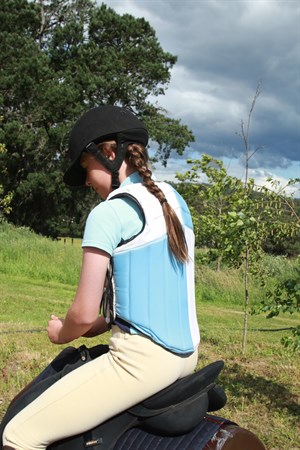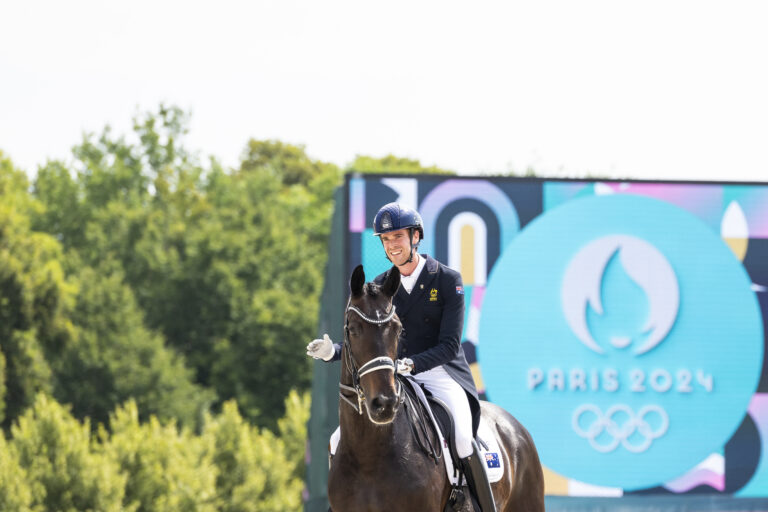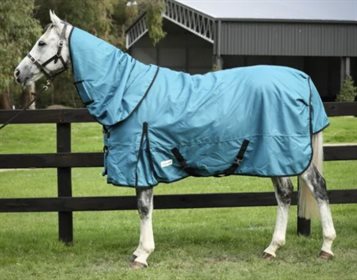This vest fits perfectly
© Peta Elstrek
By Peta Elstrek
DESIGNED TO ABSORB impact from a fall or kick from a horse, body protectors are compulsory for some competitions. But an increasing number of riders report feeling more confident – and therefore riding more positively – when wearing one in everyday situations from hacking to schooling over fences. Back protectors are encouraged to be worn in all disciplines from eventing to reining and camp drafting, and if an air jacket is being worn they are still required to be worn underneath.
Another reason many more riders are opting for body protection is that modern garments are more flexible and lightweight than their predecessors. Not only that, 21st century body protectors come in fun, fashionable colours (or plain, if you prefer), are quick and easy to put on, and don’t necessarily cost as much as you may think. Fabrics used in the manufacturing of back protectors can vary from mesh to robust nylon, covering thick, high-density foam. Fastenings and adjustments range from zips, laces, Velcro and elastic.
What’s the best body protector for you?
The British Equestrian Trade Association (BETA) originally brought together riding organisations, doctors, riders, manufacturers and retailers to develop the now widely recognised BETA Body Protector Standard. The BETA standard sets criteria for shock-absorption, controls the area of the body that must be covered and ensures there are minimal gaps between the protective foam panels. It encompasses three levels, each designed for different activities and denoted by a colour-coded label on the garment.
Level 1 (black label) provides the lowest level of protection only considered appropriate for licensed jockeys while racing.
Level 2 (brown) offers a lower than normal level of protection, so is considered suitable for low-risk situations – not including jumping, riding on the roads, riding young or excitable horses or riding while inexperienced.
Level 3 (purple) is considered appropriate for general riding, competitions including eventing and working with horses. Level 3 body protectors should prevent minor bruising that would have produced stiffness and pain, reduce soft-tissue injuries and prevent a limited number of rib fractures.

This vest is way too big
© Peta Elstrek
There is a separate BETA standard for shoulder protectors. Research into falls onto the shoulder during eventing competitions revealed that wearing shoulder protection reduces the risk of breaking your collarbone by up to 80 per cent.
Make the most of your body protector
The foam will expand back to its original shape within 30 minutes; but if a dent is showing on examination, then it’s likely that this part of the garment has lost its impact absorption properties and should be replaced.
Hidden damage that a body protector may have sustained is also a good reason for avoiding second-hand garments or those with unknown histories. Taking good care of your body protector means that it will last longer within the three to five year recommended lifespan. Don’t leave it lying around to be chewed and trodden on. Spending too much time in a hot car or damp tack room won’t do it any good either. When not in use, body protectors should be hung on a clothes hanger. Doing up zips ensures they keep their shape, while closing Velcro fastenings will help prevent them becoming clogged with horsehair and hay particles.
Most body protectors are made from heat-sensitive PVC nitrile foam, which is why they feel increasingly comfortable as they soften and mould to the wearer’s body. So try storing your protector in a warm (but not artificially hot) environment to ensure it’s nice and flexible for that early morning ride.
READ THE LATEST NEWS ARTICLES HERE








